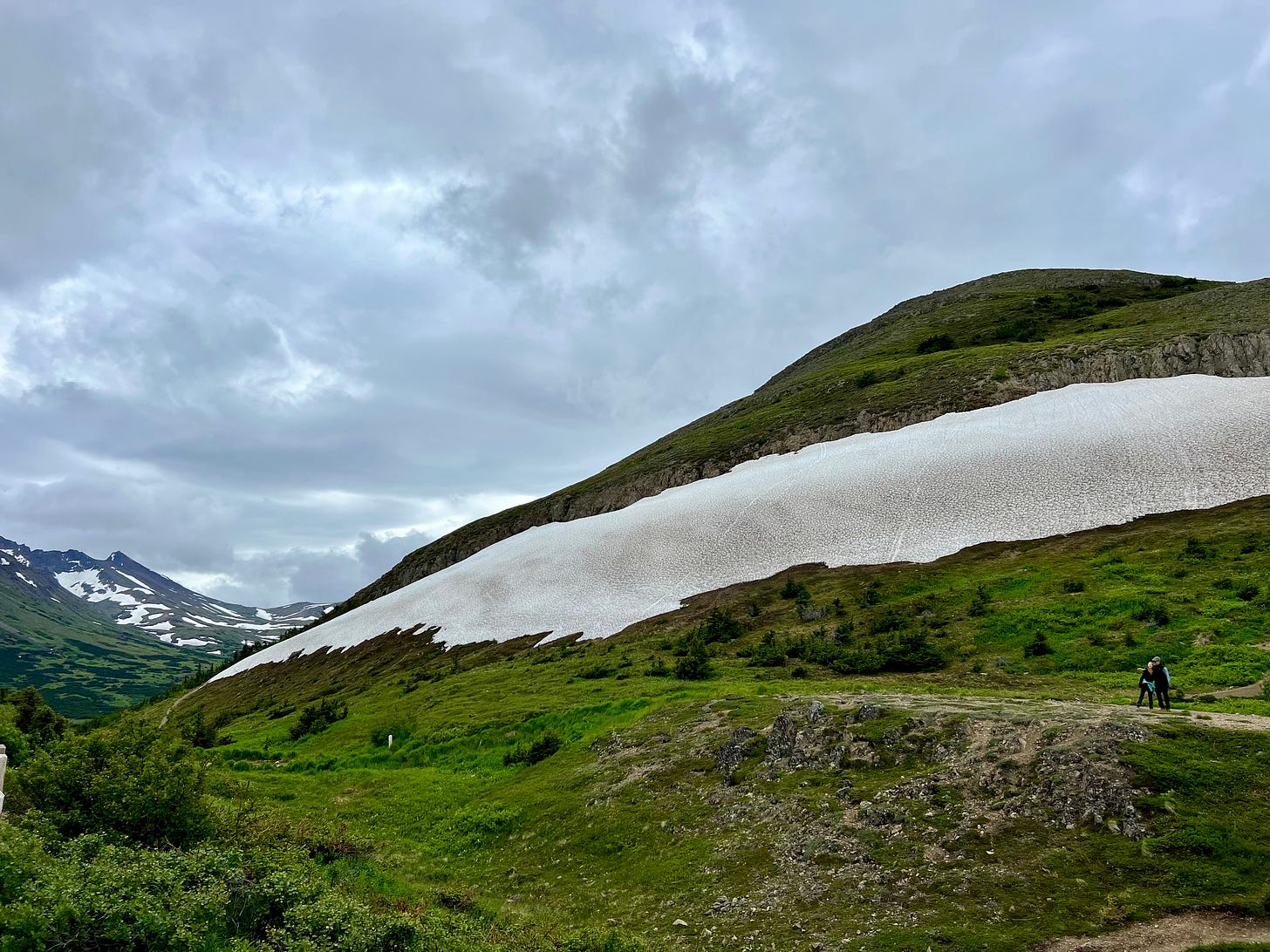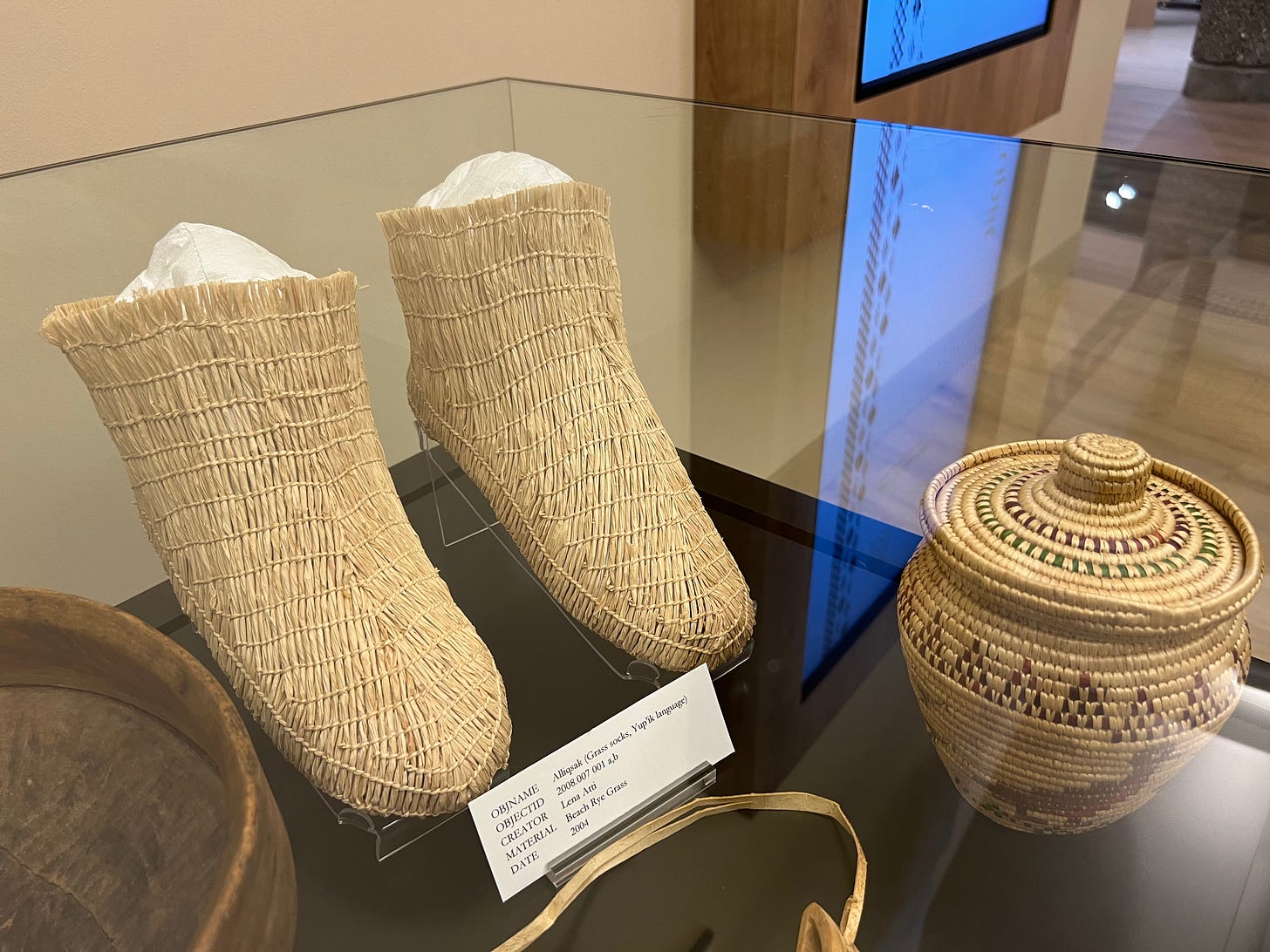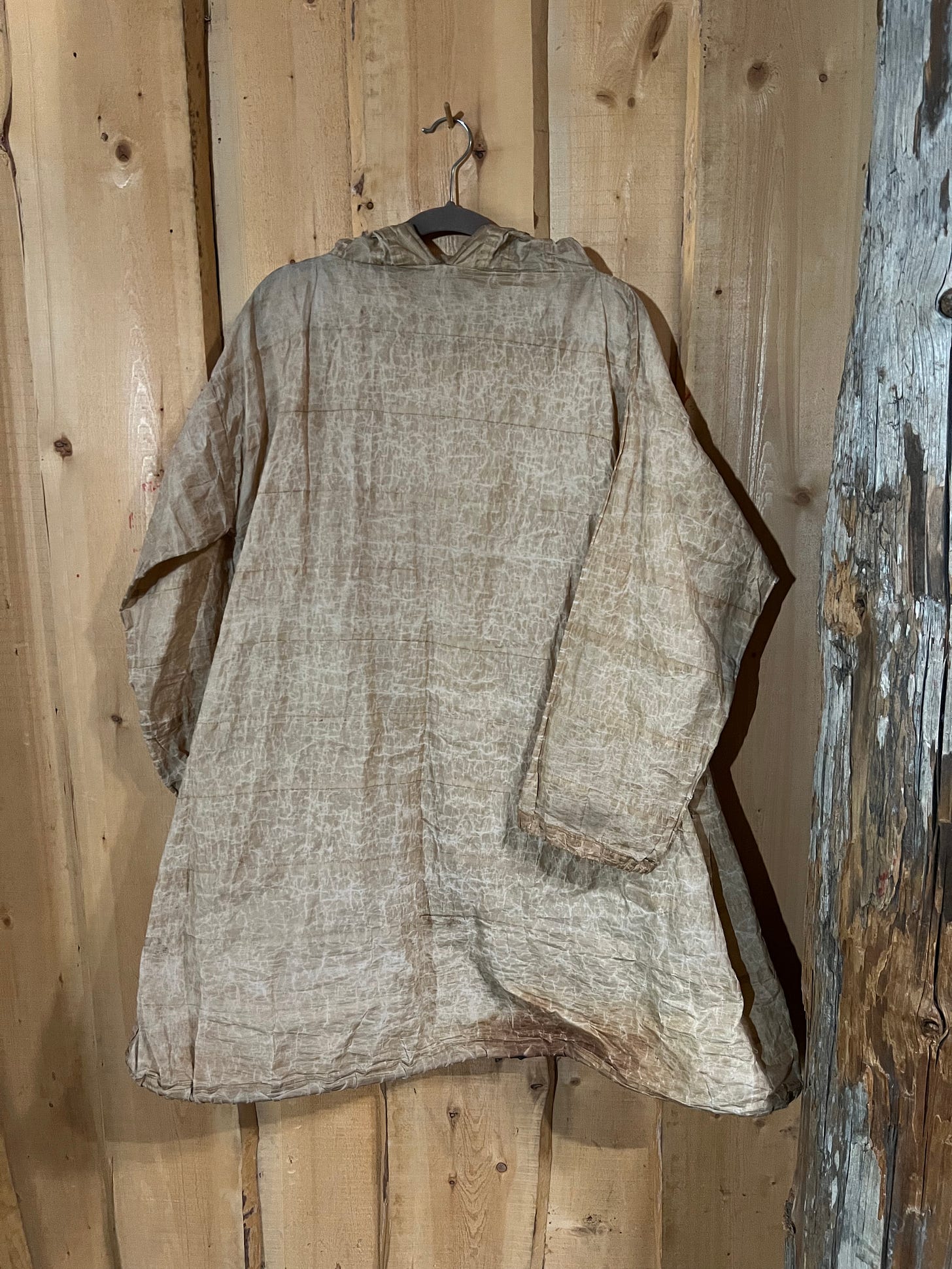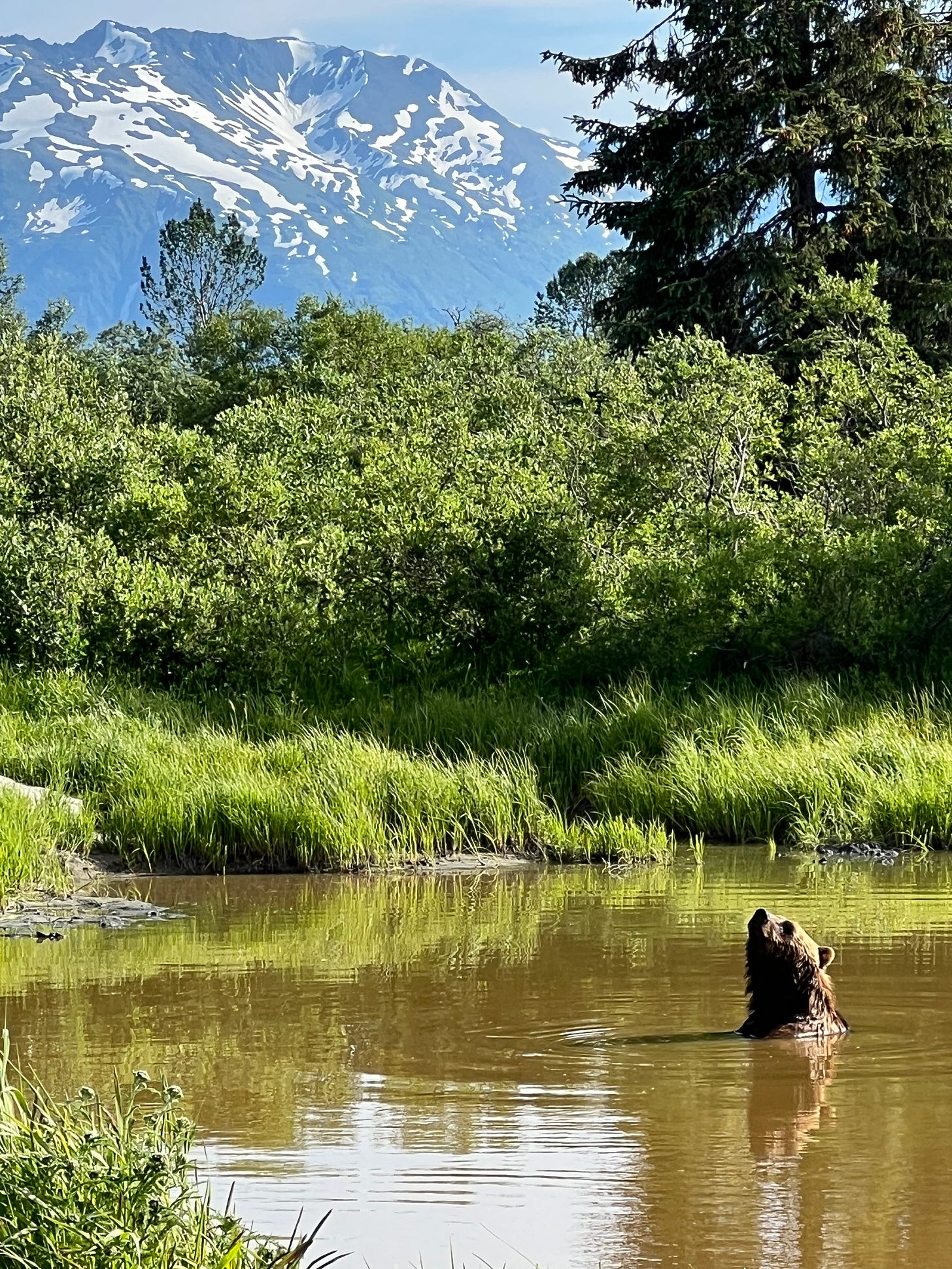Dear Readers and Friends,
Have you ever been asked a question that makes you learn something new about yourself in the response? That’s how I felt considering
’s thoughtful questions. She reached out to me to see if I’d be interested in answering six prompts about nature writing. I was honored, though I’d never thought of myself as a nature writer before! So a huge thanks to Julie and I hope you’ll take a look at her writing on Homecoming, where she explores the edges of life on earth with gratitude, awe, and wonder.I could ‘see’ how small I was on that mountain and how little my short life mattered. It was scary, but it was also ok. I felt wiser when I made it out of the woods.” ~ Jessica Becker. Read the interview here.

Big. Beautiful. Bright.
Do you know how it is when you return from a place, or a vacation, and everyone asks “How was it?” with genuine curiosity? I am having a hard time summing up my first time in Alaska, which was over the summer solstice.
Alaska is big!
Alaska is beautiful!
Alaska is bright!
"I might float away into the heavy summer sunlight,” wrote Ernestine Saankaláxt Hayes in her book, THE TAO OF RAVEN: An Alaska Native Memoir. She is a Tlingit writer from Juneau, a former Alaska State Writer Laureate, and professor emerita. Her words, and that book, were my guide to Alaska. It gave me a tiny but generous window into a complicated landscape of ancient and modern cultures. Like any good guide or introduction, it opened up more questions about the big, bright, beautiful world than it answered.
I was visiting Alaska with my stepmother, who lived in Alaska as a younger person, working as a news anchor and documentary film producer, so she also served as a guide for my family. And like many Americans who journey to Alaska these days, we spent much of our time on a cruise ship. The ship’s naturalist is a friend of the family’s, so we also benefited from her deep passion for the wild spaces and animals of the majestic and mysterious land that was signed into statehood 110 years after my state in the lower 48.
After finishing the cruise, we spent a few days in Anchorage and visited the Alaska Native Heritage Center. In 1987, the Alaska Federation of Natives unanimously voted to establish a statewide Alaska Native culture center. Two years later they opened the Heritage Center near the biggest city in the state, where more than 40% of Alaska’s population lives. It was built and is run by people Native Alaskan people as a hub of statewide collaboration, celebration, and education.
When we arrived, four people who all looked to be around 20 years old were onstage narrating and demonstrating events from the World Eskimo Olympics, games rooted in ancestral hunting and survival techniques that can only be competed in by Inuit, Iñupiat, Yupik, and other Native Americans.
It was an amazing place!
We are what we weave
Baskets have been made by humans on every continent, in every culture, since the beginning of time. I’ve said it here before (read my Made by Hand story), but it continues to fill me with awe and wonder — and hope — to know that every basket made today is still made by hand. There is no machine that can make a basket.
“Spruce root basketry, young, tough, spring trailings tightly pulled together to hold seal oil, cooking water, tasty berries, or loosely woven to hold fresh clams, branches, children’s playthings, manifests an ancient human understanding that blends stunning art and daily life persuaded to breath by the touch of basket-weavers. My family once owned baskets woven from spruce root by the hands of basket-weaving artists, relatives who could admit to such accomplishments with suitable modesty and pride, but I cannot.” -Ernestine Saankaláxt Hayes

We are what we wear
I’ll end with this one last ‘postcard,’ another photo from the Alaska Native Heritage Center. The photo below is of a poncho very similar in design to the rain poncho I wear, but this one was made traditionally from seal intestines to keep people cool and dry. It’s beautifully stitched and, to me, looks ultra-modern. Seems like something you might see on a runway or the Sartorialist’s IG feed, right?
When I was a kid, I didn’t think about where my food came from, and not just because I was young and lucky and well-fed. That was before people had Locovore and Hug Your Farmer bumper stickers. These “old-fashioned” ideas about eating seasonally and supporting local agriculture are relevant again, still, and many Americans today are more connected to their food sources than they were during the height of TV-dinners and newly contrived food products.
In the last couple of years, I’ve started thinking more about the ways our clothing, like our food, connects us with place. It took a lot of wisdom and skill to stay warm and cool and dry and happy before the modern global garment industry of mass-produced fashion. I have a good friend who is working hard to build the seed bank and educate farmers and buyers about the potential of our local fibershed in Wisconsin. Specifically, flax is a crop that has been grown and shaped the life, culture, and economy in climates like Wisconsin. But it takes skills and mills to make flax into linen. Linen, as you probably know, is a very useful fabric.
Thanks to Wisconsin Linen Revival, seeds are starting to flourish in this important conversation that some call slow fashion. I sure hope that when my kids are my age, local fiber accessibility and awareness is something like the local food movement is today: healthy, vibrant, and hopeful!

Thanks for reading! Thanks for being here! Thanks for wandering with me to light up our brains and liberate our spirits!
Happy summer,






Thank you for these insightful comments about your reaction to all we saw and did in Alaska. And thanks for adding the Alaska Native Heritage Center to our itinerary. Most of all, thank you for bringing your perspectives and your family along on the trip.
Thank you Jessica for sharing your adventure with such detail, I became immersed in your experience and want to learn more. Also, thank you for the bear postcard 🩷. Today, I am in FL at a justice conference with other justice folks from around the US. Thanks again!! Jan